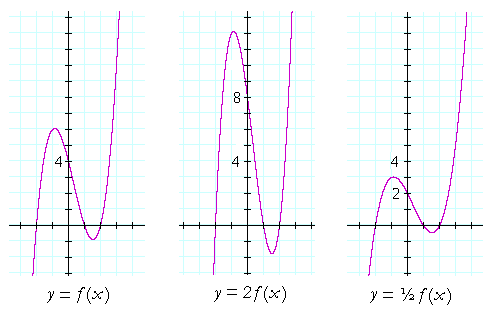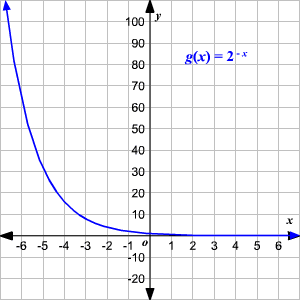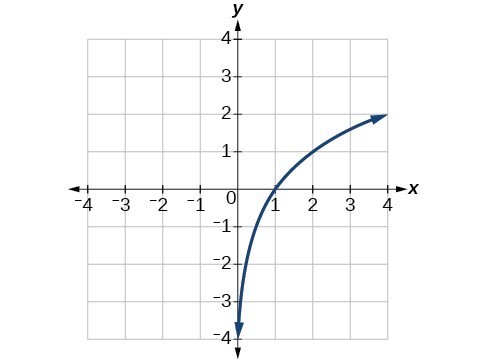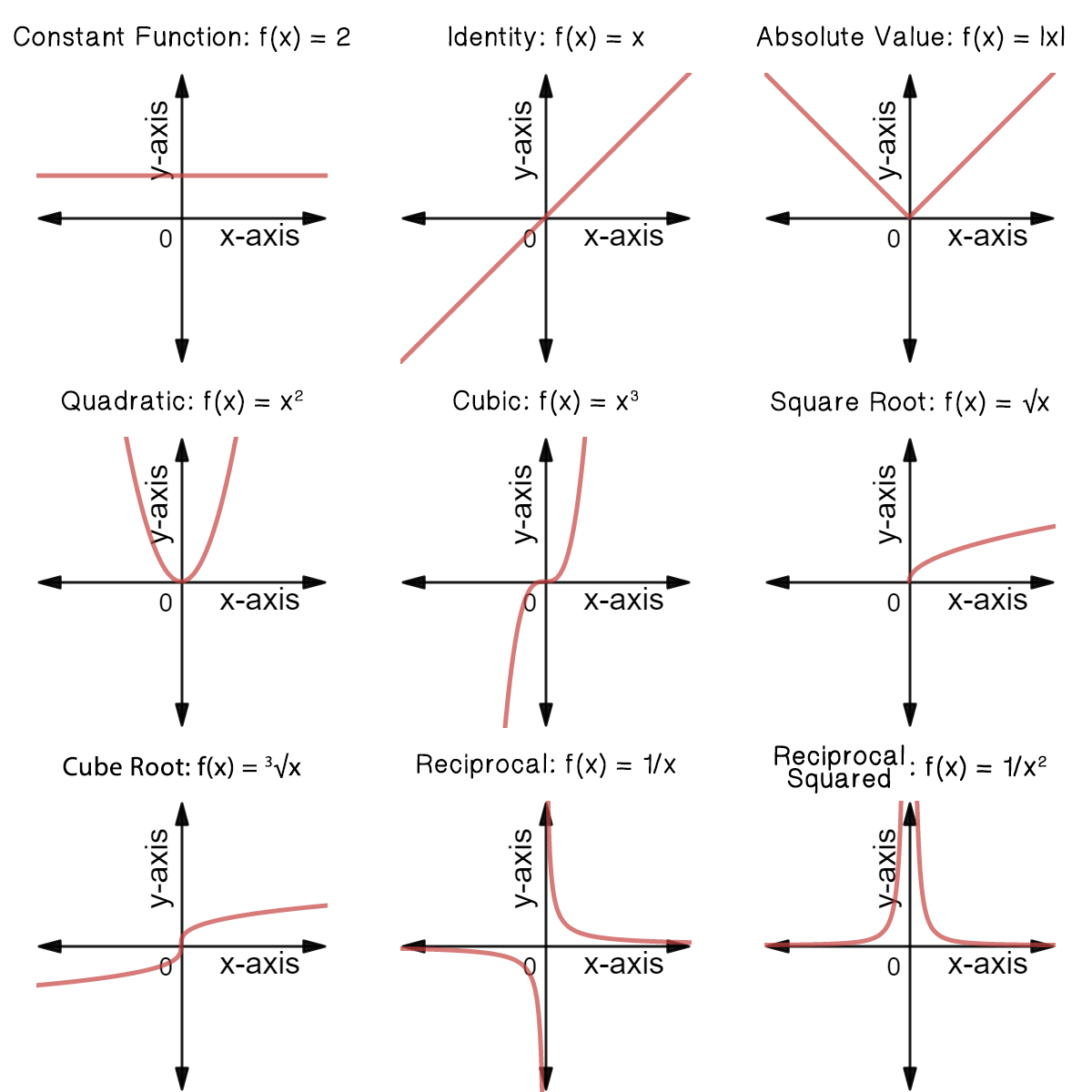Question Suppose (1, 2) is on the graph of y = f(x) Find a point on the graph of the transformed function y = f(x 5) Answer by ikleyn() (Show Source) You can put this solution on YOUR website!Get the free "Surface plot of f(x, y)" widget for your website, blog, Wordpress, Blogger, or iGoogle Find more Engineering widgets in WolframAlphaPurplemath The last two easy transformations involve flipping functions upside down (flipping them around the xaxis), and mirroring them in the yaxis The first, flipping upside down, is found by taking the negative of the original function;

Graphing Reflections Of The Basic Rational Function F X 1 X Youtube
How to graph f^-1
How to graph f^-1-Free graphing calculator instantly graphs your math problemsThe graph of \(f(x) = x^2\) is the same as the graph of \(y = x^2\) Writing graphs as functions in the form \(f(x)\) is useful when applying translations and reflections to graphs Translations




Multiplicative Inverse Wikipedia
Sketch the graphs of y f x x 2 y g x x 1 2 and h x x 2 3 on the same system of axes Name each of them 112 Beskryf in woorde die uitwerking van die parameters 1121 p en 1122 q in die vergelyking h End of previewWe will use 1 and 4 for x If x = 1, y = 2(1) 6 = 4 if x = 4, y = 2(4) 6 = 2 Thus, two solutions of the equation are (1, 4) and (4, 2) Next, we graph these ordered pairs and draw a straight line through the points as shown in the figure We use arrowheads to show that the line extends infinitely far in both directionsFor example, (1, 2) is on the graph of f (x), (1, 4) is on the graph of f (x) 2, and (1, 0) is on the graph of f (x) 2 Graphs of f (x), f (x) 2, and f (x) 2 While adding to the input increases the function in the y direction, adding to the input decreases the function in the x direction This is because the function must compensate
Figure 111 These linear functions are increasing or decreasing on (∞, ∞) and one function is a horizontal line As suggested by Figure 111, the graph of any linear function is a line One of the distinguishing features of a line is its slope The slope is the change in y for each unit change in xMultiplying the values in the domain by −1 before applying the function, f (− x), reflects the graph about the yaxis When applying multiple transformations, apply reflections first Multiplying a function by a constant other than 1, a ⋅ f (x), produces a dilation If the constant is a positive number greater than 1, the graph willLR101CYU2 (Solving twostep equations)
Find the inverse of f(x) = 2x 1 Let y = f(x), therefore y = 2x 1 swap the x"s and y"s x = 2y 1 Make y the subject of the formula 2y = x 1, so y = ½(x 1) Therefore f 1 (x) = ½(x 1) f1 (x) is the standard notation for the inverse of f(x) The inverse is said to exist if and only there is a function f1 with ff1 (x) = f1 f(x) = xPlease Subscribe here, thank you!!! The graph of f ′(x) is continuous and decreasing with an xintercept at x = 0 Which of the following statements is false?




Write The Equation For A Linear Function From The Graph Of A Line College Algebra



Calcu Rigid Transformations
The graph of y=2 x is shown to the right Here are some properties of the exponential function when the base is greater than 1 The graph passes through the point (0,1) The domain is all real numbers The range is y>0 The graph is increasing The graph is asymptotic to the xaxis as x approaches negative infinityBeyond simple math and grouping (like "(x2)(x4)"), there are some functions you can use as well Look below to see them all They are mostly standard functions written as you might expect You can also use "pi" and "e" as their respective constants Please See answer below Given f(x) = x^2 1 You can use point plotting Select any x value and then calculate the y value and plot ul(" "x" " " "y" ") ""4" "" "17 ""2" "" "5 " "0" "" "1 " "2" "" "5 " "4" "" "17 or you can realize that x^2 1 is a vertical shift up 1 of the parent function f(x) = x^2 or you can just graph the function using a graphing calculator



Q Tbn And9gcsl0jyluxfxjjcizs7jyiyflsxbm6hpbpzdawckl4kjhmo0pmir Usqp Cau



Operations On Functions Translations Sparknotes
In particular, the peak of the original curve has shifted from #x=1# to #x=1/2# On the other hand, the graph for #y=f(x/2)# is Note that this graph is twice as broad (squeezing by #1/2# being the same as stretching by a factor of 2), and the peak has also moved from #x=1# to #x=2# A special mention must be made of the case where #b# is negative It is best perhaps to Macailah H asked • The graph of y=f (x) is shown below Graph y=1/2f (x) The grap is a partial line , showing to be negative The yint is 3 and the slope is 1/2 FollowIf you wish to sketch y = 1 f ( x) given the graph of y = f ( x), some things to note are f ( x) and 1 f ( x) have the same sign y = 1 f ( x) d y d x = − f ′ ( x) f ( x) 2;



Www Crsd Org Cms Lib Pa Centricity Domain 386 Section 2 6 notes key Pdf




The Graph Of F Is Given By Draw The Graphs Of The Following Functions A Y F X 3 B Y F X 1 C Y Frac 1 2 F X D Y F X Study Com
//googl/JQ8NysThe Graphs of y = 1/x and y = 1/x^2 College AlgebraSimple transformation for y=f(x) functionFunctions & Graphing Calculator \square!




The Graph Of Y F X Is Given Below Y 1 4 01 Quad 12 Then The Graph Of Y Pm F 1 X 1




This Is The Graph Of F X 4 1 2 X What Is The Horizontal Asymptote Of F X Brainly Com
Answer The function g = f ( x 1) 2 is a line at y = 4 that extends from x = − 3 to x = 1 See explanation and graph View Answer Topics Graphs andDetermine the coordinates of any two points which lie on the line Join these two points by a straight line, and extend it on both sides That's the line you want The equation of the line mathy=\cfrac{1}{2}x3/math has been given in the slopeGet stepbystep solutions from expert tutors as fast as 1530 minutes Your first 5 questions are on us!




Translations Of A Graph Topics In Precalculus




Answered Below Is A Graph Of Y F X 3d 3 1 Bartleby
Starting at y=2f(x), click on the circle to reveal a new graph Describe the transformation Click again to remove and try the next function 3 y = 2 f x 4 y = f x 2 5 y = f x − 3 6 y = f x 4 7 y = f x − 5 8 18Find stepbystep Calculus solutions and your answer to the following textbook question Sketch the graph of the function f(x,y)=(44x^2y^2)^1/2Intuitively, a function is a process that associates each element of a set X, to a single element of a set Y Formally, a function f from a set X to a set Y is defined by a set G of ordered pairs (x, y) with x ∈ X, y ∈ Y, such that every element of X is the first component of exactly one ordered pair in G In other words, for every x in X, there is exactly one element y such that the




Graphing Absolute Value Functions Video Khan Academy



Search Q Graph Transformations Tbm Isch
Algebra questions and answers;Consider the graph of y = f(x) below y (1,2) y = f(x) (2, 0) (0, 0) (2,0) x (1, 2) C A Sketch the graph of y = f 2 1 y C Sketch the graph of y = f(x 1) 1Thinking of the graph of f (x) = x 4, graph f (x – 2) 1 The graph of f ( x ) = x 4 looks like this Looking at the expression for this translation, the " 1 " outside the function tells me that the graph is going to be moved up by one unit




How To Graph Y 1 2x Youtube




Multiplicative Inverse Wikipedia
11 Uni Grad 17 #4 Try experimenting with an original graph Note that the f (x) is the y value of that original graph Substitute that y value into 1/f (x), and then you will see that 1/f (x) is a reciprocal function Also, note that if at a point, f (x) = 1, then 1/f (x) > 1/1 = 1C < 0 moves it downPlot sqrt(1 x y), sqrt(x^2 y^2 2 x y) Natural Language;




Domain And Range Of Exponential And Logarithmic Functions



Www Apsva Us Wp Content Uploads Legacy Assets Washingtonlee 3163bc16 Derivative Graph Notes Pdf
The point you are asking for is (4,2)Answer to The graph of y = f(x) is shown below Graph y = 1 over 2 f(x) By signing up, you'll get thousands of stepbystep solutions to yourThe graph of a function is contained in a Cartesian product of sets An X–Y plane is a cartesian product of two lines, called X and Y, while a cylinder is a cartesian product of a line and a circle, whose height, radius, and angle assign precise locations of the points Fibre bundles are not Cartesian products, but appear to be up close




A Graph Of Y F X Follows No Formula For F Is Chegg Com



Graphing Quadratic Functions
Extended Keyboard Examples Upload Random Examples Upload RandomTranscribed image text 1 For f(x) = the slope of the graph of y=f(x) is known to be 1x² at the point with 25 xcoordinate 2 Find the equation of the tangent line at that point (Type an equation Use integers or fractions for any numbers in the equation)What is the graph of y=x1 and y=2x?




The Graph Of Y F X Is Shown Below Graph Y 1 2 Chegg Com




Reciprocal Graphs Sketch And Hence Find The Reciprocal Graph Y 0 Y 1 Y 2 Y 1 2 Y 3 Y 1 3 X 1 Y 0 Hyperbola Asymptote Domain X R 1 Ppt Download
Graph of y = x looks like a V at the origin The "right side" is the line y = x and the "left side" is the line y = x f(xc) shifts a function's graph c units to the left So y=x1 is the above graph bDrawing graphs of y=1/f(x) and y=I1/f(x)I from y=f(x) New Resources DOWNLOADHD!!F9 Fast and Furious 9 (21) 1080P Full OnlineGraph f(x)=y The function declaration varies according to , but the input function only contains the variable Assume Rewrite the function as an equation Use the slopeintercept form to find the slope and yintercept



F X F X 2 F X 2




Reciprocal Function Properties Graph And Examples
Let us start with a function, in this case it is f(x) = x 2, but it could be anything f(x) = x 2 Here are some simple things we can do to move or scale it on the graph We can move it up or down by adding a constant to the yvalue g(x) = x 2 C Note to move the line down, we use a negative value for C C > 0 moves it up;Question graph the function y=f(x1)2 y=2f(x1) y=f(x1) Answer by ikleyn() (Show Source) You can put this solution on YOUR website!So 1 f ( x) increases as f ( x) decreases and vice versa (minimum turning points become maximum turning points, etc) x intercepts of y = f ( x) correspond to



Exponential Functions




Answered Consider The Graph Of The Function F X Bartleby
Okay, So we are going to use why equals f of X to help us graph this equation So we have f of 1/2 X And because the one happens next to the X, that tells us that we're going to divide all of our X coordinates by 1/2 Or multiply that by two because you have to multiply about the reciprocal which is to So we have native four Tom's, too, Which 1 You are correct, given any function f ( x), you get the graph of f ( x ) by taking the graph of f, deleting the graph where x < 0, then reflecting the graph where x > 0 into the region you deleted To understand the answer described in your second paragraph, think of f ( x − 1 ) as g ( x − 1) where we define g as the new function gGraph of z = f(x,y) New Resources Pythagoras' Theorem Area dissection 2;



Graphing Quadratic Functions




Lesson Explainer Function Transformations Dilation Nagwa
F(x) (a,b) 7!(a,b) flip over the xaxis Examples • The graph of f(x)=x2 is a graph that we know how to draw It's drawn on page 59 We can use this graph that we know and the chart above to draw f(x)2, f(x) 2, 2f(x), 1 2f(x), and f(x) Or to write the previous five functionsThe graph of f(x) in this example is the graph of y = x 2 3 It is easy to generate points on the graph Choose a value for the first coordinate, then evaluate f at that number to find the second coordinate The following table shows several values for x and the function f evaluated at those numbers x 2 1 0 1 2 f(x) 1Use the graph of y= 1/ f(x) to graph y= f(x) Posted In Alberta, Math 1 Answered By Albert S I'm not really sure what responding to this task proves




Graph Represents A Function Y F X Mathematics 1 2 3



Graphing Quadratic Functions
(4 points) The graph of f has an inflection point at x = 0 The graph of f has a relative maximum at x = mathInverse functions f(x)=4x2 & g(x)=5x6Remember f(x) reflects the graph to the right of theThe graph of y = f (x) is the graph of y = f (x) reflected about the yaxis Here is a picture of the graph of g(x) =(05x)31 It is obtained from the graph of f(x) = 05x31 by reflecting it in the yaxis Summary of Transformations To graph Draw the graph of f and Changes in the equation of y = f(x) Vertical Shifts y = f (x) c



Http Snelsonmath Pbworks Com F 4 4 Reteach Solutions Pdf




Igcse Fmc 1 Sketching Graphs Dr J Frost
Answer to Consider the graph of y = f(x) below y (1,2) y = Math; Its graph is shown below From the side view, it appears that the minimum value of this function is around 500 A level curve of a function f (x,y) is a set of points (x,y) in the plane such that f (x,y)=c for a fixed value c Example 5 The level curves of f (x,y) = x 2 y 2 are curves of the form x 2 y 2 =c for different choices of cThat is, the rule for this transformation is –f (x) To see how this works, take a look at the graph of h(x) = x 2 2x – 3




The Graph Of Y Fx Is Shown Below Graph Y 1 2 Fx Gauthmath




One To One Function Explanation Examples
I can not graph it, because the post does not define the function f(x) Without it, the problem CAN NOT be answered



Sat Math Graph Example 2 Sat Math Forbest Academy




Vocabulary L L L The Function Fx X




16 5 1 Vertical Transformations Mathematics Libretexts



Solution Graph The Given Function By Making A Table Of Coordinates F X 2 X




Graphing Square Root Functions



Http Www Jmap Org Worksheets A Rei D 11 Othersystems1 Pdf




Draw The Graph Of Y 1 1 X



1




Warm Up 1 Use The Graph Of To Sketch The Graph Of 2 Use The Graph Of To Sketch The Graph Of Ppt Download




The Graph Of Y F X Is Shown Below Graph Y F 1 2 Chegg Com




Functions Algebra Mathematics A Level Revision




How Do You Graph Y 2x 1 By Plotting Points Socratic




Graph Graph Equations With Step By Step Math Problem Solver




Graph Dfgh With Vertices F 2 2 G 2 4 And H 4 4 And Its Image After The Similarity Transformation Dilation X Y X 2 Y 2 Reflection In The Y Axis Homework Help And Answers Slader



The Graph Of F X Is Shown In Red Draw The Graph Of G X F X 4 876 5 4 3 2 1 678 After Finishing The Graph Click Outside The Course Hero




Transformation Of Graphs Y F X Into Y 2f X 1 Quick Explanation Youtube




Me Suremen Ur Unswers The Question 1 Which Graph Represents The Function Y 3x 1 For The Domain Brainly Com



Multiplicative Inverse Wikipedia



Biomath Transformation Of Graphs




The Graph Of Y F X Is Shown Below Graph Y 1 Over 2 F X Study Com




Ch1 Graphs Y Axis X Axis Quadrant I Quadrant Ii Quadrant Iii Quadrant Iv Origin 0 0 6 3 5 2 When Distinct Ppt Download



Operations On Functions Translations Sparknotes



Ca Schoolwires Net Cms Lib Ca Centricity Domain 0 Ch1section2notes1617 Pdf



What Is The Graph Of X 2 Y 3 X 2 2 1 Quora




The Graph Of Y F X Is Shown Below Graph Of Y Chegg Com




Graph Graph Equations With Step By Step Math Problem Solver




How To Graph A Parabola Y 1 2 X 3 2 5 Socratic




The Graph Of Y Fx Is Shown Below Graph Y 1 2 Fx Gauthmath



What Does F 0 Represent On The Graph Of F X Quora




How Do You Graph Y X 1 2 4 Socratic



Www Shsu Edu Kws006 Precalculus 1 2 Function Graphs Files S 26z 1 6 Pdf



Www Humbleisd Net Cms Lib2 Tx Centricity Domain 3611 Answer review final exam fall Pdf




The Characteristics Of The Graph Of A Reciprocal Function Graphs And Functions And Simultaneous Equations




Use The Graph Of A Function To Graph Its Inverse College Algebra



Search Q F 2x Tbm Isch




What Is A Function Transformation Expii




The Graph Of Y Fx Is Shown Below Graph Y 1 2 Fx Gauthmath




Horizontal Line Test For Function To Have Inverse Expii




The Graph Of Y F X Is Shown Below Graph Y 1 2 Chegg Com




2 5 Vertical Transformations Mathematics Libretexts



Solved If The Point 4 7 Lies On The Graph Of 2y 2 F 1 5 X 1 What Is The Corresponding Point On The Graph Of Y F X Show Your Work Course Hero




Graph Graph Equations With Step By Step Math Problem Solver




Consider The Graph Of F X 1 2 X The Graph Of Function G Is Graph Because The Graph Of Function G Brainly Com



Mathscene Functions 1 Lesson 3




How To Draw Y 2 X 2 Interactive Mathematics




Graphing Reflections Of The Basic Rational Function F X 1 X Youtube




4 1 Exponential Functions And Their Graphs



Solution Sketch The Graph Of Y 1 2x 2 2 Find The Domain Of The Function F X X 2 X 4 Find The Domain Of The Function G T 5t T 2 9 Use The Vertical Line Test To




Linear Functions And Their Graphs




Matlab Tutorial




Transforming Exponential Graphs Example 2 Video Khan Academy




3 Ways To Graph A Function Wikihow




The Graph Of Y F X Is Shown Below Graph Y 1 2 Chegg Com




Graphing Parabolas



Operations On Functions Stretches And Shrinks Sparknotes




The Graph Of F Is Given Draw The Graphs Of The Following Functions A Y F X 3 B Y F X 1 C Y Frac 1 2 F X D Y




Graph The Linear Equation Yx 2 1 Draw



Math Scene Equations Iii Lesson 3 Quadratic Equations




Classifying Common Functions Expii



Www Hoodriver K12 Or Us Cms Lib Or Centricity Domain 230 Ch 5 pt answer key Pdf



Http Www Mpsaz Org Rmhs Staff Lxcoleman Algebra2 Reviews Files 1 1 1 2 Algebra 2 Review Answer Key Pdf




The Graph Of Y F X Is Shown Below Graph Chegg Com




3 2 2 Worksheet Day 2




If The Graph Of The Function Y F X Is As Shown The Graph Of Y 1 2 F X F X Is




Use The Graph Of A Function To Graph Its Inverse College Algebra




Desmos Graphing Calculator



Operations On Functions Stretches And Shrinks Sparknotes



If The Graph Of The Function Y F X Is As Shown Then The Graph Of Y 1 2 F X F X Is Sarthaks Econnect Largest Online Education Community




Use The Given Graph Of F X To Sketch A Graph Of Y 2f X Study Com




Given The Graph Of F X Draw The Graph Each One Of The Following Functions Img Src D10lpgp6xz60nq Cloudfront Net Physics Images Cen Cal C01 E15 007 Q01 Png Width 80 A Y F X 3 B Y F X 2 C Y F X 1 2 D Y




How Do You Graph Y X 2 1 Socratic




Answered The Graph Of Y F X Is Shown Below Bartleby


